
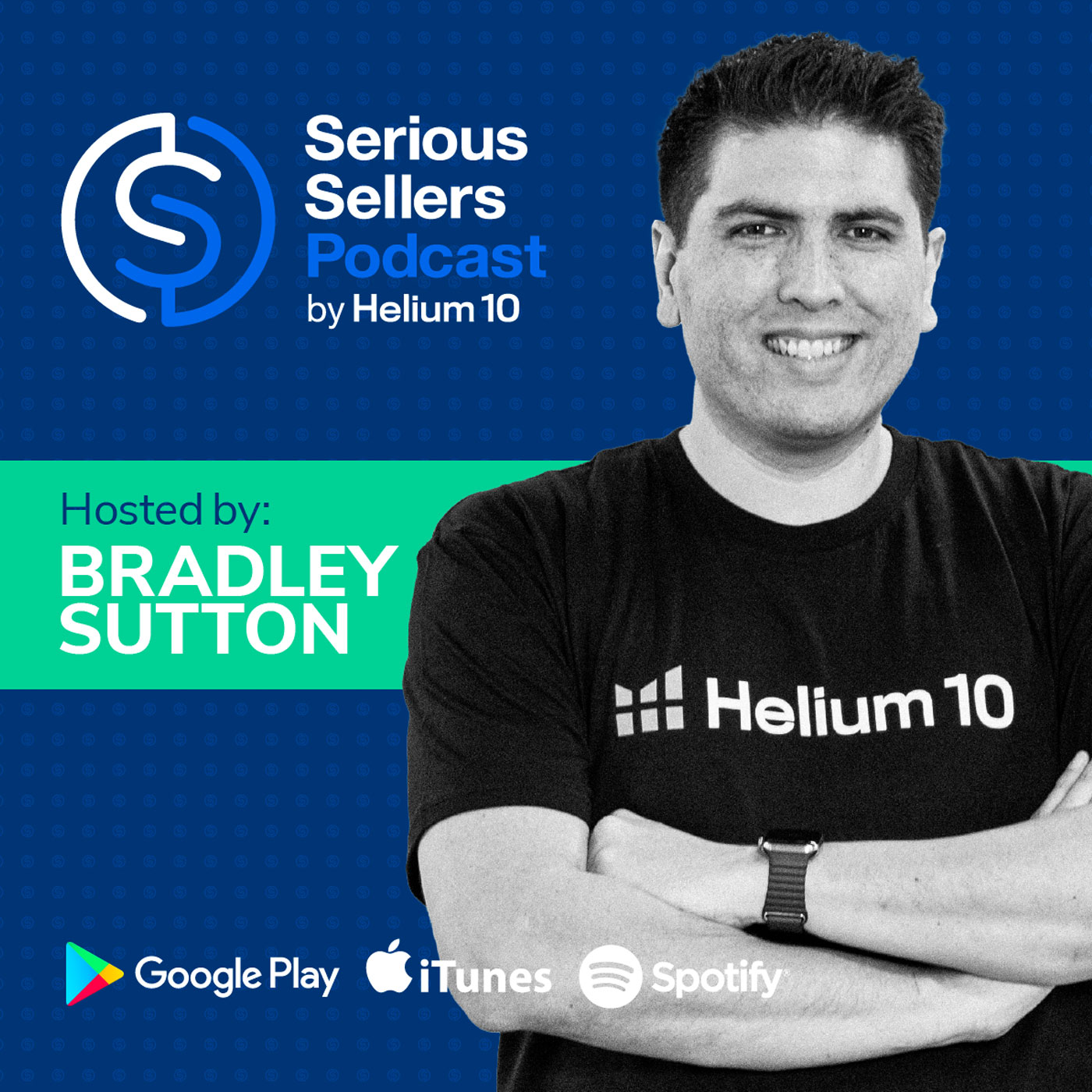
4.1M
Downloads
924
Episodes
Are you an Amazon FBA, TikTok Shop, Walmart, or Ecommerce Seller, or someone interested in becoming one? The Serious Sellers Podcast by Helium 10 is an unscripted, unrehearsed, BS-free, organic conversation between host Bradley Sutton, and real life sellers and thought leaders in the ecommerce world, where they share the top strategies that will help sellers of all levels succeed. In addition, every week there is an episode of the ”Weekly Buzz” which gives a rundown of the latest news in the Ecommerce world. ► Instagram: instagram.com/serioussellerspodcast ► Free Amazon Seller Chrome Extension: https://h10.me/extension ► Sign Up For Helium 10: https://h10.me/signup (Use SSP10 To Save 10% For Life) ► Learn How To Sell on Amazon: https://h10.me/ft ► Watch The Podcasts On Youtube: youtube.com/@Helium10/videos
Episodes
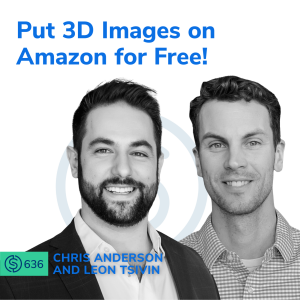
Saturday Feb 01, 2025
#636 - Put 3D Images on Amazon for Free!
Saturday Feb 01, 2025
Saturday Feb 01, 2025
In this episode, we've got a couple of representatives from Amazon who work in a department that has now made it available for all sellers to quickly produce and upload 3D renderings of your products.
► Instagram: instagram.com/serioussellerspodcast
► Free Amazon Seller Chrome Extension: https://h10.me/extension
► Sign Up For Helium 10: https://h10.me/signup (Use SSP10 To Save 10% For Life)
► Learn How To Sell on Amazon: https://h10.me/ft
► Watch The Podcasts On YouTube: youtube.com/@Helium10/videos
What if you could transform your Amazon listings with the power of 3D technology? Join us for an insightful episode of the Serious Sellers Podcast where we explore this very possibility with Leon Tsivin and Chris Anderson from Amazon's Visual Innovation Team. These trailblazers are reshaping the e-commerce landscape by introducing Amazon sellers to groundbreaking advancements in 3D product renderings. Discover how these new interactive models, a leap beyond traditional 360-degree spin files, are set to enhance customer experience and boost purchase confidence, leading to a more engaging shopping journey.
Leon and Chris share their expertise on the evolution of 3D imaging, taking us through its fascinating journey from augmented reality furniture features to virtual try-ons for eyewear and shoes. Get an insider's look at the technical process behind creating these compelling models, from constructing the geometry to the final lighting touches. This episode also demystifies how customers can now explore products in a more immersive way, and how sellers can capitalize on these advances to gain a competitive edge on Amazon.
In the final part of our discussion, we dive into the practicalities of creating and managing 3D models on Amazon. Leon and Chris explain how sellers can utilize Amazon's mobile scanning tool to create free 3D models of their product using just a smartphone. We also cover important aspects like the submission and review process, device compatibility, and options for sellers without physical products ready. By the end of this episode, you'll understand not only the technicalities but also the strategic advantages of integrating 3D models into your Amazon listings, ultimately empowering your brand's presence in the fast-paced world of e-commerce. Don't miss this opportunity to learn from the visionaries at the forefront of visual innovation.
In episode 636 of the Serious Sellers Podcast, Bradley, Chris, and Leon discuss:
- 00:00 - Amazon Representatives Discuss 3D Product Renderings
- 07:13 - Introduction to 3D Product Imaging
- 05:57 - The Impact of 3D Shopping Experiences
- 12:09 - Amazon 3D Product Demos
- 13:59 - Creating 3D Models for Amazon Sellers
- 19:08 - 3D Scanning Process for Products
- 22:30 - File Download Limitations on Amazon
- 25:14 - Uploading 3D Models to Amazon Seller Central
- 29:33 - Submitting and Reviewing 3D Models
- 30:18 - Leveraging 3D Images for Amazon Success
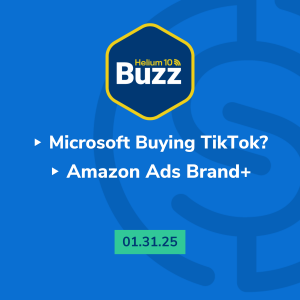
Friday Jan 31, 2025
Helium 10 Buzz 1/31/25: Microsoft Buying TikTok? | Amazon Ads Brand+
Friday Jan 31, 2025
Friday Jan 31, 2025
Is Microsoft buying TikTok? Amazon Ads Brand+ launches for DSP users. A UPS change may impact how much you have to pay to send inventory to Amazon. These buzzing news and more in today’s episode!
► Instagram: instagram.com/serioussellerspodcast
► Free Amazon Seller Chrome Extension: https://h10.me/extension
► Sign Up For Helium 10: https://h10.me/signup (Use SSP10 To Save 10% For Life)
► Learn How To Sell on Amazon: https://h10.me/ft
► Watch The Podcasts On YouTube: youtube.com/@Helium10/videos
We’re back with another episode of the Weekly Buzz with Helium 10’s VP of Education and Strategy, Bradley Sutton. Every week, we cover the latest breaking news in the Amazon, Walmart, and E-commerce space, talk about Helium 10’s newest features, and provide a training tip for the week for serious sellers of any level.
Microsoft in talks to buy TikTok, Trump says
https://www.bbc.com/news/articles/c4g3z55zz7xo
Amazon Ads Launches Brand+, A Way For Marketers To Leverage Shopping, Browsing And Streaming Data From Amazon’s Total Footprint
https://deadline.com/2025/01/amazon-ads-launches-brand-plus-tool-shopping-browsing-streaming-data-1236269306/
NEW PRODUCT ANNOUNCEMENT: Amazon Ads launches Brand+ in beta for the Amazon DSP, an industry first AI-driven optimization capability for brand awareness campaigns
https://www.linkedin.com/posts/jeffreycohen_amazonads-aiadvertising-streamingtv-activity-7289739667539668994-m1US
UPS announces major cutback in Amazon relationship
https://www.ajc.com/news/business/ups-to-cut-amazon-partnership-by-more-than-50/IP7G7JFWUJDWVCBAB4YE53M5AI/
Flip, the TikTok Shop rival, launches a creator fund that grants up to $100M of equity value
https://techcrunch.com/2025/01/24/flip-launches-a-creator-fund-that-grants-up-to-100m-of-equity/
Freedom Ticket By Helium 10 - Amazon Influencer Bootcamp:
https://learning.helium10.com/products/freedom-ticket-4-0/categories/2156270528
Listen in as we uncover the latest tools for Amazon influencers using Helium 10, offering valuable insights into enhancing their earning potential. This new Helium 10 feature allows influencers to track video placements on Amazon, optimizing their strategies for maximum visibility and income. Switching to influencer mode on the Helium 10 Chrome extension provides further advantages, with data on existing influencer video placements. In our training tip of the week, we clarify the distinction between indexing and ranking on Amazon, highlighting the importance of these concepts for improved searchability and strategic planning. Discover how influencers inside the Amazon Influencer Program can harness Helium 10's tools to boost their content's performance and thrive in the Amazon Influencer Program.
In this episode of the Weekly Buzz by Helium 10, Bradley covers:
- 01:06 - MicroTok?
- 02:59 - Amazon Brand+
- 04:47 - Amazon / UPS Cutback
- 06:53 - Flip Marketplace
- 09:18 - Freedom Ticket: Amazon Influencer Bootcamp
- 10:27 - Helium 10 New Feature Alerts
- 14:01 - Training Tip: Check if Your Indexed for Keywords
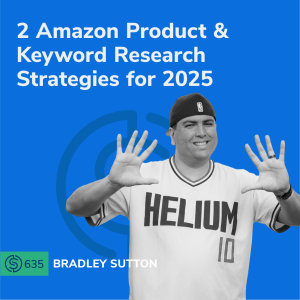
Tuesday Jan 28, 2025
#635 - 2 Amazon Product & Keyword Research Strategies for 2025
Tuesday Jan 28, 2025
Tuesday Jan 28, 2025
In this episode, we discuss two killer product and keyword research strategies. One of them found a product that has sold tens of thousands of dollars, but I found this product opportunity nine months ago.
► Instagram: instagram.com/serioussellerspodcast
► Free Amazon Seller Chrome Extension: https://h10.me/extension
► Sign Up For Helium 10: https://h10.me/signup (Use SSP10 To Save 10% For Life)
► Learn How To Sell on Amazon: https://h10.me/ft
► Watch The Podcasts On YouTube: youtube.com/@Helium10/videos
Ever wondered how some Amazon sellers manage to uncover hidden e-commerce gems while the rest of us are left playing catch-up? Imagine having the tools and insights to identify high-performing products, long before they hit the big time. On this episode of the Serious Sellers Podcast, we break down the art and science of Amazon products and keyword research for 2025. From Bradley’s personal success with the "Meat Resting Blanket" to the specifics of navigating Amazon's algorithm, this episode has strategies that can elevate your Amazon-selling game.
Join me as Bradley walks you through the power-packed features of Helium 10. We’ll explore niche markets that are ripe for the picking and how to harness the potential of Amazon's brand analytics. You'll get insider tips on dissecting search results to identify products with high click rates but low conversions, a surefire way to uncover untapped opportunities. This episode is not just about finding products; it’s about mastering the art of listening to what the market is quietly whispering.
Last but not least, we dive into the nuances of product visibility and keyword relevance. Discover advanced strategies for optimizing your Amazon listings with Helium 10’s Magnet, Black Box, and Cerebro, and learn how keyword seasonality can impact your sales cycles. Plus, a sneak peek at how Amazon's AI is reshaping product listings and why understanding its algorithm could be your secret weapon. Are you ready to transform your approach and maximize your e-commerce potential? Tune in for actionable insights and a fresh perspective on the game-changing Amazon tools for 2025.
In episode 635 of the Serious Sellers Podcast, Bradley talks about:
- 00:00 - Amazon Product and Keyword Research Strategies
- 01:36 - Keyword Research Tools for Amazon Sellers
- 07:18 - Identifying Niche Products Through Brand Analytics
- 12:46 - Exploring Unfamiliar Keywords and Products
- 17:25 - Keyword Research Strategies and Historical Data
- 19:49 - Discovering Top-Selling Products in Brand Analytics
- 23:48 - Advanced Keyword Research Strategies
- 24:53 - Discovering Top Keywords With Amazon Data
- 31:57 - Amazon AI for Product Seasonality
- 35:15 - Amazon Product Sales Analysis & Seasonality
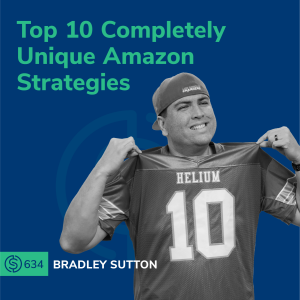
Saturday Jan 25, 2025
#634 - Top 10 Completely Unique Amazon Strategies
Saturday Jan 25, 2025
Saturday Jan 25, 2025
In this episode, learn Bradley’s top 10 all-time money-making strategies that you can't do with any other tool outside of Helium 10. Including one strategy adding $5K profit from a product selling just 5 units a day!
► Instagram: instagram.com/serioussellerspodcast
► Free Amazon Seller Chrome Extension: https://h10.me/extension
► Sign Up For Helium 10: https://h10.me/signup (Use SSP10 To Save 10% For Life)
► Learn How To Sell on Amazon: https://h10.me/ft
► Watch The Podcasts On YouTube: youtube.com/@Helium10/videos
Join Bradley as he shares his top 10 unique money-making strategies exclusively available to Helium 10 users. These strategies, often overlooked by the average Amazon seller, are designed to provide a competitive edge and significantly boost your profits. He shares how one particular strategy added over $5,000 in profit for a product selling just five units a day. By comparing Helium 10's functionalities with other Amazon tools out there, Bradley highlights the potential for substantial gains by utilizing features available to Helium 10 users. This episode is packed with insights into lesser-known techniques that can supercharge your Amazon business for maximum profitability, even during off-peak times.
Listen in as Bradley reveals advanced Amazon product research techniques using Helium 10's tools that can revolutionize your approach to analyzing product performance and keyword effectiveness. Discover how to leverage the historical Cerebro feature to track high-performing seasonal products currently out of stock and understand what drove their sales during their peak season. We also dive into Amazon Brand Analytics tools inside Helium 10 to streamline the process of identifying top-clicked keywords for seasonal products. By analyzing a broader date range, you can uncover a comprehensive list of keywords that led to significant clicks and conversions, enhancing your product's market strategy.
Finally, Bradley guides you through strategies to determine if your product is indexed for a keyword on Amazon. Learn how the Index Checker tool can efficiently identify which specific keywords are preventing a product from being indexed for certain phrases. He also explores the importance of understanding shifts in keyword ranks and how these shifts can explain changes in sales performance. With insights into optimizing packaging size for immediate savings. This is a look at 10 strategies most Amazon sellers and Helium 10 users overlook, this episode offers a comprehensive guide to maximizing your profits and refining your Amazon-selling and e-commerce strategy using Helium 10.
In episode 634 of the Serious Sellers Podcast, Bradley talks about:
- 03:19 - #1 Cerebro Historical Trend
- 08:39 - #2 ABA Top Search Terms
- 11:40 - #3 Cerebro Historial Search Volume & Rank
- 15:21 - #4 Amazon Recommended Rank
- 20:11 - #5 Child ASIN Variation Sales Performance
- 21:55 - #6 Cerebro Data Shows All 7 Pages
- 24:59 - #7 Helium 10 Index Checker
- 29:07 - #8 Keyword Sales Estimates
- 31:17 - #9 Keyword Tracker with Boost
- 33:48 - #10 Size Tier Alerts
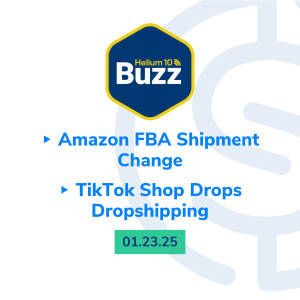
Thursday Jan 23, 2025
Helium 10 Buzz 1/23/25: Amazon FBA Shipment Change | TikTok Drops Dropshipping
Thursday Jan 23, 2025
Thursday Jan 23, 2025
An Amazon FBA shipment change, TikTok shop not allowing dropshipping anymore, and Walmart launching an in-home testing program. These and more buzzing news on this week's episode!
► Instagram: instagram.com/serioussellerspodcast
► Free Amazon Seller Chrome Extension: https://h10.me/extension
► Sign Up For Helium 10: https://h10.me/signup (Use SSP10 To Save 10% For Life)
► Learn How To Sell on Amazon: https://h10.me/ft
► Watch The Podcasts On YouTube: youtube.com/@Helium10/videos
We’re back with another episode of the Weekly Buzz with Helium 10’s Senior Brand Evangelist, Shivali Patel. Every week, we cover the latest breaking news in the Amazon, Walmart, and E-commerce space, talk about Helium 10’s newest features, and provide a training tip for the week for serious sellers of any level.
Amazon FBA Shipment Change
https://sellercentral.amazon.com/help/hub/reference/GC3Q44PBK8BXQW3Z
TikTok Shop Drops Dropshipping
The TikTok outage caused TikTok Shop sales to spike, not sink
https://digiday.com/marketing/the-tiktok-outage-caused-tiktok-shop-sales-to-spike-not-sink/
Apple, Google remove TikTok from stores as app halts service in U.S.
https://www.cnbc.com/2025/01/18/apple-google-remove-tiktok-from-stores-as-app-halts-service-in-us.html
Apple won't return TikTok to the App Store until it's sold to a U.S. buyer
https://appleinsider.com/articles/25/01/21/apple-wont-return-tiktok-to-the-app-store-until-its-sold-to-a-us-buyer
Walmart will now let suppliers test products in its customers’ homes
https://www.modernretail.co/operations/walmart-will-now-let-suppliers-test-products-in-its-customers-homes/
Inventory Defect and Reimbursement portal now available
https://sellercentral.amazon.com/seller-news/articles/QVRWUERLSUtYMERFUiNHRkVaMk1ZR05KWFNDSEw2
New Features for Amazon Advertisers
https://advertising.amazon.com/API/docs/en-us/release-notes/index
New Amazon product title requirements effective January 21, 2025
https://sellercentral.amazon.com/seller-news/articles/QVRWUERLSUtYMERFUiNHNEJGOUZIUUs4SFBXWkRV
In the next segment, we turn our attention to exciting new Helium 10 product features and updates in the Amazon marketplace. We introduce powerful features inside Helium 10 Adtomic like the Share of Voice tool. This tool is designed to enhance brand visibility and streamline advertising campaigns. Furthermore, Shivali guides us through a compelling strategy for expanding product offerings by leveraging niche book topics by using Helium 10’s Black Box tool for KDP allowing sellers to tap into new markets and diversify income streams. By identifying high-potential keywords with low competition, sellers can capitalize on existing skills and broaden their market presence. Don't miss this episode for a comprehensive look at these critical updates and strategies to enhance your e-commerce success.
In this episode of the Weekly Buzz by Helium 10, Bradley covers:
- 00:47 - Amazon FBA Shipment Change
- 02:34 - TikTok Shop Drops Dropshipping
- 04:23 - TikTok Sales Spike
- 05:36 - TikTok App Unavailable
- 07:06 - Walmart’s Scintilla
- 08:59 - IDR Portal LIVE
- 10:33 - New Features for Advertisers
- 12:06 - Title Policy Reminder
- 12:51 - Helium 10 New Feature Alerts
- 19:09 - Training Tip: Black Box For KDP
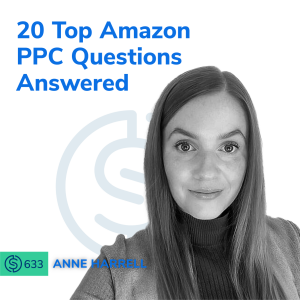
Tuesday Jan 21, 2025
#633 - 20 Top Amazon PPC Questions Answered
Tuesday Jan 21, 2025
Tuesday Jan 21, 2025
In this TACoS Tuesday episode, we answer over 20 of your top Amazon PPC questions with the help of our first-time expert guest who brings a wealth of knowledge to our show.
► Instagram: instagram.com/serioussellerspodcast
► Free Amazon Seller Chrome Extension: https://h10.me/extension
► Sign Up For Helium 10: https://h10.me/signup (Use SSP10 To Save 10% For Life)
► Learn How To Sell on Amazon: https://h10.me/ft
► Watch The Podcasts On YouTube: youtube.com/@Helium10/videos
How can you elevate your Amazon advertising game and maximize your e-commerce success? Join us as we welcome Anne Harrell, Head of Product Evangelism & Enablement from Pacvue, to answer over 20 of the most pressing PPC questions from our listeners. Bradley and Anne's deep expertise offers a fresh perspective on how Helium 10 and Pacvue can complement each other, helping brands at various stages of their Amazon-selling journey. She dives into the latest innovations Amazon has lined up for 2024, like AMC and expanded sponsored ads, which aim to give sellers unprecedented insights into customer behavior.
Throughout the episode, Anne shares actionable strategies for mastering Amazon ad campaigns. Bradley and Anne also break down the complexities of setting up effective campaigns, sharing how tech tools like Helium 10’s Keyword Tracker can fine-tune your bids beyond basic estimates. We also touch on the power of automation with tools inside Pacvue, which can alleviate the burdens of manual campaign management and enhance overall efficiency. Anne emphasizes the role of external traffic and audience maximization within Amazon's ecosystem, offering a balanced approach to boost organic sales alongside advertising efforts.
Finally, we explore the nuances of Amazon PPC strategy, from mitigating rising ACoS to the strategic use of AI in campaign management. Anne shares her fascinating journey from the advertising world to her pivotal role at Pacvue, along with resources like TACoS Tuesday for those keen on deepening their PPC knowledge. Whether you're working to optimize your PPC campaigns or looking to learn effective strategies, this episode is packed with insights to fuel your Amazon success story.
In episode 633 of the Serious Sellers Podcast, Bradley and Anne discuss:
- 00:00 - Amazon Advertising Solutions
- 02:57 - Helium 10 and Pacvue
- 06:32 - Amazon Ads, CES Announcement
- 08:30 - PPC Campaign Optimization Strategies
- 09:25 - Optimizing Keyword Bids for Product Launch
- 12:42 - Optimizing Amazon Campaigns for Keywords
- 16:05 - Optimizing Campaign Management Frequency
- 22:56 - Effective Ad vs. Organic Sales Ratio
- 23:34 - Driving Sales Through Advertising and Optimization
- 28:34 - Finding Trending Keywords for Sponsored Products
- 32:22 - Product Display Ads Optimization & Competitor Avoidance
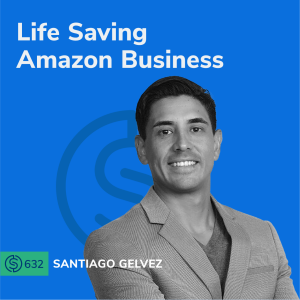
Saturday Jan 18, 2025
#632 - Life-Saving Amazon Business
Saturday Jan 18, 2025
Saturday Jan 18, 2025
In this episode, an Amazon seller shares how creating products to save his dog launched his brand, leading to Amazon featuring his inspiring story on its website.
► Instagram: instagram.com/serioussellerspodcast
► Free Amazon Seller Chrome Extension: https://h10.me/extension
► Sign Up For Helium 10: https://h10.me/signup (Use SSP10 To Save 10% For Life)
► Learn How To Sell on Amazon: https://h10.me/ft
► Watch The Podcasts On YouTube: youtube.com/@Helium10/videos
Join us for an inspiring conversation with Santiago Gelvez of PetCultures.com, a Colombian-born entrepreneur whose heartwarming journey to save his dog Tango sparked an innovative adventure in the pet product industry. Santiago's transition from a career with giants like Procter & Gamble and PepsiCo to founding a thriving e-commerce brand is a riveting tale of passion and perseverance. Discover how a personal crisis and a collaboration with a veterinarian friend led to the creation of a groundbreaking pet probiotic that not only improved Tango's health but also caught Amazon's attention, turning Santiago's entrepreneurial dream into a flourishing reality.
Santiago opened up about his strategic expansion into the European market, sharing key insights into the unique challenges and opportunities he faced. Learn about his experience relocating to Europe and how it unveiled lower competition and cost per acquisition, proving crucial for growth in the pet supplement sector. Santiago emphasizes the importance of Amazon's Subscribe and Save feature, which has been instrumental in fostering customer loyalty and achieving profitability. Through his story, Santiago underscores the need for patience and strategic planning in the competitive landscape of online supplements.
Marketing is at the heart of Santiago's success, and he generously shares his strategies for brand growth. From offering enticing discounts to crafting compelling personal stories, Santiago's approach is both innovative and relatable. He discusses the power of storytelling in branding, particularly the role of his journey with Tango, and explains how workshops with industry experts like Kevin King have fueled his brand's expansion across European marketplaces. This episode is a treasure trove of advice for aspiring entrepreneurs looking to make their mark in the pet product industry and beyond.
In episode 632 of the Serious Sellers Podcast, Bradley and Santiago discuss:
- 00:00 - From Procter & Gamble to Pet Products
- 00:00 - Seller's Amazon Success Story
- 04:27 - Ineffective Probiotics for Pets
- 07:44 - Starting a Business and Making Profit
- 09:47 - Expansion Through European Markets and Strategies
- 18:31 - Pricing Strategy and Amazon Subscribe & Save
- 18:37 - Pet Products Marketing and Global Expansion
- 26:30 - Amazon Mexico Regulatory Challenge
- 29:59 - Pet Supplement Brand Marketing Strategy
- 30:38 - Expanding Brand in European Amazon Markets
- 33:50 - Private Label Product Launch Strategy
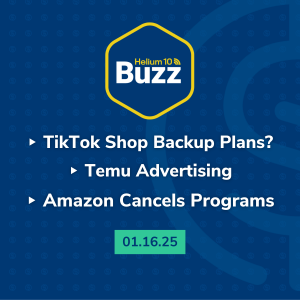
Thursday Jan 16, 2025
Thursday Jan 16, 2025
TikTok Shop sellers are looking at backup plans in case it's banned. Temu is now going to start charging for advertising. Amazon discontinues two programs. These buzzing stories and more on today's episode!
► Instagram: instagram.com/serioussellerspodcast
► Free Amazon Seller Chrome Extension: https://h10.me/extension
► Sign Up For Helium 10: https://h10.me/signup (Use SSP10 To Save 10% For Life)
► Learn How To Sell on Amazon: https://h10.me/ft
► Watch The Podcasts On YouTube: youtube.com/@Helium10/videos
We’re back with another episode of the Weekly Buzz with Helium 10’s VP of Education and Strategy, Bradley Sutton. Every week, we cover the latest breaking news in the Amazon, Walmart, and E-commerce space, talk about Helium 10’s newest features, and provide a training tip for the week for serious sellers of any level.
Tech war: China’s TikTok sellers eye Amazon and Shein as US ban looms
https://www.scmp.com/tech/tech-war/article/3294719/tech-war-chinas-tiktok-sellers-eye-amazon-and-shein-us-ban-looms
Temu Trials Amazon-Killer Search Ad Business
https://www.tipranks.com/news/temu-nasdaqpdd-trials-amazon-killer-search-ad-business
Updates to packaging requirements for sharp products
https://sellercentral.amazon.com/seller-news/articles/QVRWUERLSUtYMERFUiNHM0EzVzhSV0ZGQ1VQSzla
Amazon to shut down ‘Try Before You Buy’ rival to Stitch Fix
https://www.cnbc.com/2025/01/10/amazon-to-shut-down-stitch-fix-competitor-prime-try-before-you-buy.html
Boost sales of more sustainable products with Climate Pledge Friendly
https://sellercentral.amazon.com/seller-news/articles/QVRWUERLSUtYMERFUiNHTERTQUJEUktKQ0NTOVFB
Amazon’s 360-degree image experience to be discontinued
https://sellercentral.amazon.com/seller-news/articles/QVRWUERLSUtYMERFUiNHQkVLSzJKWTZRTEtGU1hD
Amazon Autos launches online sales
https://www.automotivedive.com/news/customers-can-add-vehicles-hyundai-shopping-cart-amazon-autos/736716/
In the final segment, we shift our focus to cutting-edge tools and events that empower sellers. Discover how Helium 10's newest feature enhances keyword research, helping sellers identify high-converting keywords and uncover lucrative market gaps. We share strategic insights for manufacturers, like those in the bamboo niche, to capitalize on market opportunities. Don't miss the details about our upcoming Helium 10 Elite workshop and AMZ Hacking Live Event in Berlin, where industry luminaries like Kevin King will provide indispensable insights into the e-commerce world. Prepare to elevate your e-commerce game with the knowledge and strategies shared in this episode.
In this episode of the Weekly Buzz by Helium 10, Bradley covers:
- 01:01 - TikTok Shop Alternatives?
- 03:42 - Temu Ads
- 05:57 - Amazon Sharp Products
- 09:58 - Try Before You Buy Gone
- 10:54 - Climate Pledge Friendly
- 12:11 - 360 Images Gone
- 13:27 - Amazon Cars
- 14:25 - Helium 10 New Feature Alerts
- 22:58 - Strategy of the Week
- 27:36 - Germany Events for Sellers
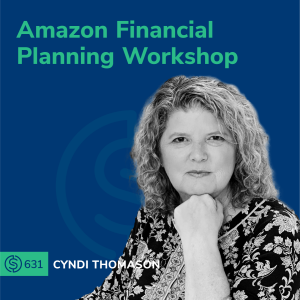
Tuesday Jan 14, 2025
#631 - Amazon Financial Planning Workshop
Tuesday Jan 14, 2025
Tuesday Jan 14, 2025
In this episode, the author of Profit First for eCommerce Sellers shares strategies to calculate, manage finances, and ensure profitability to fund your Amazon business and lifestyle.
► Instagram: instagram.com/serioussellerspodcast
► Free Amazon Seller Chrome Extension: https://h10.me/extension
► Sign Up For Helium 10: https://h10.me/signup (Use SSP10 To Save 10% For Life)
► Learn How To Sell on Amazon: https://h10.me/ft
► Watch The Podcasts On YouTube: youtube.com/@Helium10/videos
What if you could dramatically enhance your e-commerce business's profitability by making a simple shift in your financial strategy? In this episode of the Serious Sellers Podcast by Helium 10, we sit down with Cyndi Thomason, the mastermind behind "Profit First for E-Commerce Sellers." Cyndi opens up about the intricacies of cash flow management and the vital principle of paying yourself first, a step often neglected by Amazon sellers. Drawing from her extensive experience at Books Keep, Cyndi provides an in-depth analysis of the current e-commerce landscape, highlighting an intriguing scenario where revenues are climbing, yet gross profits dwindle due to rising costs.
We unravel the secrets of proactive financial planning, diving into the innovative use of multiple bank accounts to streamline your business finances. By establishing separate accounts for operating expenses, inventory, and profits, you can achieve a crystal-clear view of your cash flow and tackle the unique hurdles of inventory management. Cyndi guides us through the practicalities of this method, emphasizing the importance of setting aside funds for future inventory needs in the ever-changing market conditions.
As we dive deeper, the conversation shifts to the transformative "Profit First" model. Cyndi passionately advocates for entrepreneurs to reward themselves with regular profit distributions, likening this practice to the enjoyment of dividends from stocks. This not only celebrates success but also builds financial discipline. We also explore strategies for funding inventory and product development while keeping operational expenses in check. From understanding the nuances of real revenue to maintaining a healthy balance for taxes and owner pay, Cyndi equips us with essential tools for sustainable business growth and personal financial well-being.
In episode 631 of the Serious Sellers Podcast, Carrie, Kevin, and Cyndi discuss:
- 00:00 - Maximizing E-Commerce Profitability Strategies
- 01:28 - Profit First for E-Commerce With Cyndi Thomason
- 05:36 - Impact of Ad Spend on Profitability
- 08:38 - Understanding Profit First Behavioral Strategy
- 11:55 - Optimizing Profit Through 3 Bank Accounts
- 13:31 - Setting Up Multiple Bank Accounts
- 18:46 - Implementing Profit First Financial Strategy
- 20:00 - Building a Profit Reserve for Business
- 24:52 - Credit Cards in Business
- 29:00 - Financial Strategies for Business Growth
- 30:56 - Mindset Shift for Business Success
- 36:25 - Strategies for Business Financial Growth
- 37:20 - Managing Expenses for Product Development
- 40:45 - Cash Flow Management and Profit Maximization
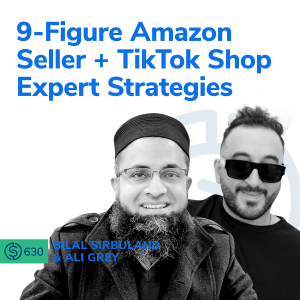
Saturday Jan 11, 2025
#630 - 9-Figure Amazon Seller + TikTok Shop Expert Strategies
Saturday Jan 11, 2025
Saturday Jan 11, 2025
This episode is a two-in-one special, with two guests for the price of one. One is one of the world's top experts on TikTok shop, and the other has sold hundreds of millions of dollars online and is even an accomplished DJ who plays at music festivals.
► Instagram: instagram.com/serioussellerspodcast
► Free Amazon Seller Chrome Extension: https://h10.me/extension
► Sign Up For Helium 10: https://h10.me/signup (Use SSP10 To Save 10% For Life)
► Learn How To Sell on Amazon: https://h10.me/ft
► Watch The Podcasts On YouTube: youtube.com/@Helium10/videos
Join us for a fascinating conversation as we welcome Ali Grey, a remarkable e-commerce expert and globetrotter, to our podcast. Ali shares his journey from London to living in Taiwan, after having worked from an impressive 70 different countries. Discover how he started his entrepreneurial journey at the young age of 15 by coding his own dropshipping website, which led him to leave school and pursue e-commerce full-time. Ali talks about his success on Amazon and his early investments in Bitcoin, which were driven by his interest in cryptography and a desire to break away from traditional financial systems.
In another exciting chapter, we explore Ali's creative side as GRY, a DJ who transitioned from organizing underground raves in London to performing at major festivals around the world. He reveals the four key strategies that propelled his e-commerce business to impressive revenue growth, including acquiring ASINs, leveraging affiliate marketing, building a strong community, and creating patented products. Ali emphasizes the importance of community and patent financing while sharing his personal preference for social media platforms.
Finally, listen in as Bilal Sirbuland, a trailblazer in the TikTok Shop space, joins the discussion to share his journey from Amazon to becoming a top seller on TikTok Shop. Bilal highlights the simplicity and opportunities TikTok Shop offers, and shares strategies for launching and scaling a business, such as focusing on viral products and leveraging TikTok's algorithm for advertising. This episode is packed with valuable insights and strategies from both Ali and Bilal, providing a comprehensive guide for aspiring e-commerce entrepreneurs looking to thrive in the ever-evolving digital selling marketplace.
In episode 630 of the Serious Sellers Podcast, Bradley, Ali, and Bilal discuss:
- 00:00 - E-Commerce Experts Discuss Success Strategies
- 06:39 - Teen Entrepreneur's Million-Dollar Gaming Venture
- 12:32 - From Raves to Festivals
- 17:43 - Value of Building Patents in Business
- 19:58 - Successful Transition to TikTok Shop
- 21:50 - Selling Brands on TikTok for Virality
- 26:27 - Selling Brands Without Influencers
- 32:47 - TikTok Shop Strategy and Pricing
- 39:52 - Selling Products on TikTok Shop